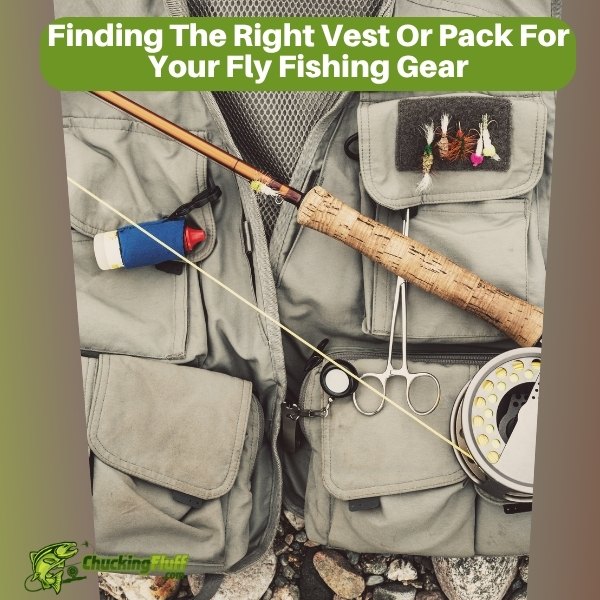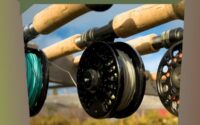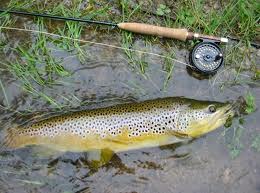| Disclosure: Just to be open and honest the buttons and links you click on in the website will in most cases take you to another website where you can purchase the products I am reviewing. As an Amazon Associate I earn from qualifying purchases. |
Finding The Right Vest Or Pack For Your Fly Fishing Gear

Fly fishing is more than just casting a line into the water—it’s a dance with nature, a blend of skill, patience, and the right gear. And when it comes to gear, your vest or pack is like your trusty sidekick, holding everything you need to make your day on the river a success. But with so many options out there, how do you pick the one that’s right for you? Whether you’re wading through a chilly mountain stream or casting from a drift boat, the right vest or pack can make or break your experience. Let’s dive into the world of fly fishing storage solutions and figure out how to find the perfect fit for your adventures.
Quick Post Navigation
- Why Your Fly Fishing Vest or Pack Matters
- Types of Fly Fishing Gear Storage Solutions
- Key Features to Look for in a Fly Fishing Vest or Pack
- How to Choose Based on Your Fishing Style
- Top Tips for Maintaining Your Fly Fishing Vest or Pack
- Balancing Style and Functionality
- Budget Considerations for Fly Fishing Gear
- Conclusion: Finding Your Perfect Fly Fishing Companion
- FAQs About Fly Fishing Vests and Packs
Why Your Fly Fishing Vest or Pack Matters
Your vest or pack isn’t just a place to stash your flies and tippet—it’s the backbone of your fishing setup. It keeps your gear organized, accessible, and protected while you’re out in the elements. Think of it like a chef’s knife roll: without it, you’re just fumbling around, hoping you can find what you need when you need it. A good vest or pack saves you time, reduces frustration, and lets you focus on what really matters—landing that elusive trout.
The Role of Comfort in Long Fishing Days
Picture this: you’re standing knee-deep in a river, the sun beating down, and your shoulders are screaming because your vest is digging into your skin. Not fun, right? Comfort is king when you’re spending hours on the water. A well-designed vest or pack distributes weight evenly, avoids chafing, and lets you move freely. Look for padded straps, breathable materials, and adjustable fits to keep you comfortable from dawn to dusk. After all, if you’re distracted by an aching back, you’re not going to notice that subtle rise on the water.
Balancing Storage and Accessibility
Storage is where your vest or pack really earns its keep. You need enough space for your fly boxes, leaders, tippet spools, nippers, floatant, and maybe even a sandwich or two. But here’s the catch: too much storage can weigh you down, and poorly organized pockets can leave you digging for that one tiny fly while a fish is rising. The best vests and packs strike a balance, offering plenty of room with intuitive pocket layouts. Think about how you fish—do you need quick access to your tools, or are you okay with a little rummaging? Your answer will guide your choice.
Types of Fly Fishing Gear Storage Solutions
Not all fly fishing storage is created equal. From classic vests to modern sling packs, each option has its own vibe and functionality. Let’s break down the main types so you can see which one feels like your fishing soulmate.
Traditional Fly Fishing Vests
The fly fishing vest is the old-school classic, like a denim jacket or a vinyl record. It’s what most anglers picture when they think of fly fishing gear—covered in pockets, slightly weathered, and full of character. Vests drape over your shoulders and chest, with pockets galore for all your essentials. They’re lightweight, breathable, and perfect for keeping everything within arm’s reach.
Pros and Cons of Vests
Pros: Vests are versatile and great for wade fishing. Their open design keeps you cool in warm weather, and the sheer number of pockets means you can carry a small tackle shop with you. They’re also adjustable, fitting a wide range of body types.
Cons: Vests can feel bulky if overloaded, and they don’t always distribute weight evenly. In cold or wet conditions, they offer little protection unless paired with a waterproof jacket. Plus, all those pockets can become a black hole for small items if you’re not organized.
Fly Fishing Chest Packs
Chest packs are the minimalist’s choice—compact, streamlined, and focused on the essentials. These packs sit high on your chest, leaving your back and sides free. They’re like the fanny pack of fly fishing, but way cooler. Chest packs are ideal for anglers who want to travel light or fish in tight spaces where a full vest might snag.
Pros and Cons of Chest Packs
Pros: Chest packs are lightweight and keep your gear front and center for easy access. They’re great for short trips or when you’re moving a lot, as they don’t restrict your range of motion. Many models are modular, letting you add or remove pouches as needed.
Cons: Limited storage is the biggest drawback. If you’re the type who likes to carry every fly in your arsenal, a chest pack might leave you wanting. They can also feel restrictive across the chest, especially for larger anglers.
Fly Fishing Backpacks and Sling Packs
For the angler who needs to haul more gear—think multi-day trips or remote waters—backpacks and sling packs are the way to go. Backpacks offer tons of storage and are built for comfort over long hauls, while sling packs combine the accessibility of a vest with the capacity of a backpack. They’re like the SUVs of fly fishing gear: roomy, rugged, and ready for adventure.
Pros and Cons of Backpacks and Sling Packs
Pros: Backpacks and sling packs shine for their capacity. You can pack extra layers, food, water, and even camera gear without blinking. Sling packs, in particular, are easy to swing around for quick access. Both are great for anglers who hike to their fishing spots.
Cons: These packs can be heavy when fully loaded, and they’re not always as breathable as vests. Sling packs can dig into one shoulder if not designed well, and backpacks might feel overkill for a quick afternoon on the water.
Key Features to Look for in a Fly Fishing Vest or Pack
No matter which style you choose, certain features can make or break your experience. Let’s talk about what to prioritize when shopping for your perfect gear carrier.
Material and Durability
Your vest or pack is going to face sun, rain, mud, and the occasional snag on a branch. Look for materials like ripstop nylon, Cordura, or high-denier polyester that can take a beating. Double-stitched seams and quality zippers are a must—cheap hardware will fail you when you’re miles from civilization. If you fish in saltwater, consider corrosion-resistant materials to keep rust at bay.
Storage Capacity and Organization
How much stuff do you really need? A minimalist might get by with a few pockets for flies and tools, while a gear junkie might want a pack with dedicated spots for everything from pliers to a hydration bladder. Look for features like D-rings, tippet holders, and retractable tool tethers to keep things tidy. Clear or mesh pockets are a bonus for spotting small items quickly.
Comfort and Fit
A vest or pack that doesn’t fit right is like wearing someone else’s shoes—awkward and annoying. Adjustable straps and padded back panels are key for comfort, especially on long days. If you’re trying on a vest, make sure it doesn’t restrict your casting motion. For packs, check that the weight sits evenly and doesn’t pull you backward when wading.
Water Resistance and Weather Protection
Mother Nature doesn’t care about your gear, so your vest or pack needs to be ready for anything. Water-resistant or waterproof materials are a must, especially for electronics or paper maps. Some packs come with built-in rain covers or roll-top closures for extra protection. Even if you’re not fishing in a downpour, wet waders can soak your gear, so plan accordingly.
How to Choose Based on Your Fishing Style
Your fishing style is as unique as your casting technique, so your vest or pack should match how you fish. Let’s break it down by scenario.
Wade Fishing vs. Boat Fishing
Wade fishing demands mobility and lightweight gear. A vest or chest pack is often the best choice here, keeping your essentials close without weighing you down in the current. Boat fishing, on the other hand, gives you more room to spread out. A backpack or sling pack can handle extra gear like snacks, extra reels, or even a first-aid kit, since you’re not carrying it on your back all day.
Day Trips vs. Multi-Day Adventures
For a quick day trip, a vest or chest pack is usually enough to carry the basics. You’re in and out, focusing on fishing rather than survival. But for multi-day adventures, especially in remote areas, a backpack is your best bet. Look for one with enough room for food, water, and extra clothing, plus attachment points for rods or nets. Sling packs can work for an overnight trip if you pack light.
Top Tips for Maintaining Your Fly Fishing Vest or Pack
Your vest or pack is an investment, so treat it right to make it last. A little TLC goes a long way in keeping your gear in top shape.
Cleaning and Storage
After a trip, shake out any dirt or debris and wipe down your vest or pack with a damp cloth. For stubborn stains, use mild soap and water, but avoid harsh detergents that can damage coatings. Let it air dry completely before storing to prevent mold. Store your gear in a cool, dry place, away from direct sunlight, to avoid fading or material breakdown.
Inspecting for Wear and Tear
Before each season, give your vest or pack a thorough check. Look for frayed seams, broken zippers, or worn-out straps. Small tears can often be patched with gear repair tape, but don’t ignore bigger issues—replace your gear if it’s failing. A broken strap in the middle of a river is the last thing you need.
Balancing Style and Functionality
Let’s be honest: you want to look good on the water. Your vest or pack doesn’t have to be just functional—it can reflect your personality too.
Color and Aesthetics
Neutral colors like olive, khaki, or gray blend into natural surroundings, which is great for stealthy fishing. But if you want to stand out, some brands offer bold colors or patterns. Just make sure the color doesn’t spook fish in clear water. Reflective strips or bright accents can also add visibility for safety in low-light conditions.
Customization Options
Some vests and packs let you add patches, extra pouches, or even custom embroidery. This is a great way to make your gear feel personal while adding functionality. Modular systems are especially cool, letting you swap out pockets or add rod holders as needed.
Budget Considerations for Fly Fishing Gear
Fly fishing gear can range from budget-friendly to “sell your car” expensive. Here’s how to navigate the price spectrum without sacrificing quality.
Entry-Level Options
You don’t need to break the bank to get a solid vest or pack. Entry-level options from reputable brands offer decent durability and storage for under $100. Look for sales or last season’s models to score a deal. Just make sure the materials and zippers aren’t flimsy—cheap gear falls apart fast.
Premium Vests and Packs
If you’re a serious angler, investing in a high-end vest or pack can be worth it. Premium models often use better materials, offer more thoughtful designs, and come with warranties. Expect to pay $150–$300 for top-tier gear that’ll last for years. Think of it like buying a good rod—you get what you pay for.
Conclusion: Finding Your Perfect Fly Fishing Companion
Choosing the right vest or pack for your fly fishing gear is about understanding your needs, your fishing style, and what makes you comfortable on the water. Whether you go for a classic vest, a sleek chest pack, or a rugged backpack, prioritize comfort, storage, and durability. Think about where and how you fish, and don’t be afraid to try on a few options to find the perfect fit. With the right gear on your back, you’ll spend less time fumbling and more time casting to that rising trout. So, get out there, experiment, and find the vest or pack that feels like an extension of you.
FAQs About Fly Fishing Vests and Packs
1. What’s the main difference between a fly fishing vest and a chest pack?
A vest offers more pockets and a traditional design, spreading weight across your shoulders. A chest pack is compact, sits high on your chest, and is ideal for minimalists or quick trips.
2. Can I use a regular backpack for fly fishing?
You can, but it’s not ideal. Fly fishing backpacks have specialized features like rod holders, waterproof compartments, and better weight distribution for wading.
3. How do I know if a vest or pack fits properly?
It should feel snug but not restrictive, with no chafing or slipping. Test it with your fishing gear loaded and mimic casting motions to ensure comfort.
4. Are waterproof vests or packs worth the extra cost?
If you fish in wet conditions or carry electronics, waterproof options are a lifesaver. For dry climates or casual trips, water-resistant materials might suffice.
5. How often should I replace my fly fishing vest or pack?
With proper care, a quality vest or pack can last 5–10 years. Replace it if you notice significant wear, like broken zippers or large tears, that can’t be repaired.


